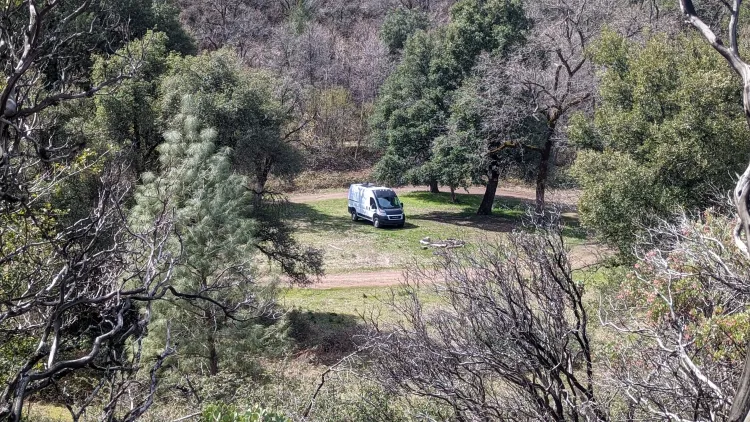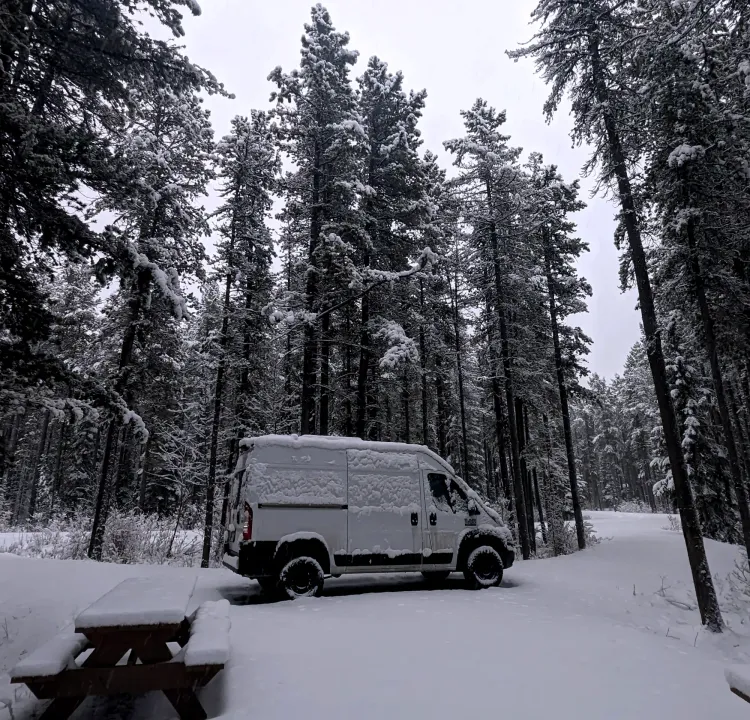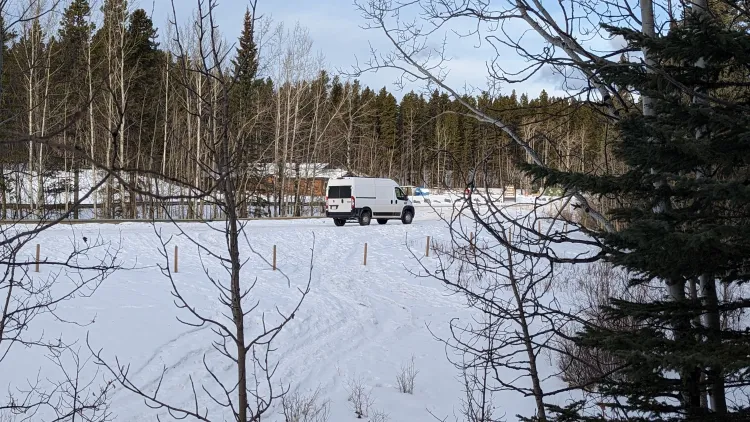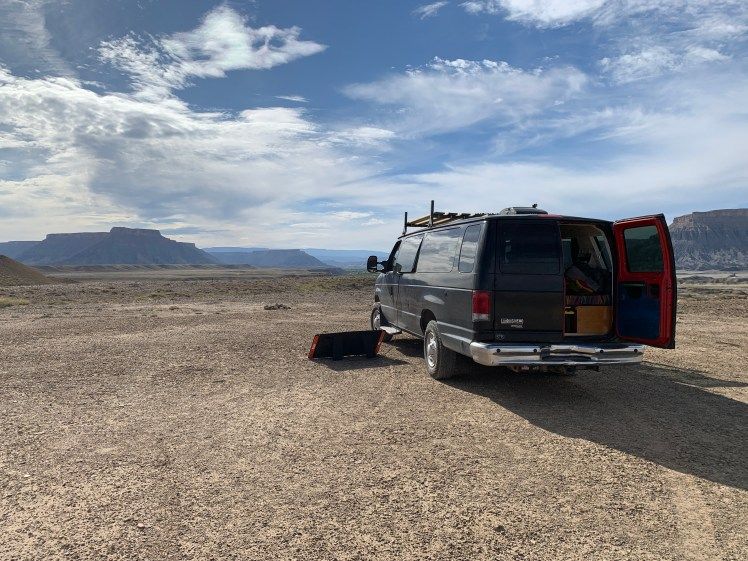Van Camping - How to Find the Best Spots to Sleep and Stay

Perhaps one of the most important daily struggles of van life is knowing where to stay and sleep. This blog post will show you how! Unfortunately, there isn't a complete answer to this question and it depends on many factors like how legal you want it to be, how safe you want to feel, and how remote you might want to exist.
Finding a spot to stay in your van is a daily task. There are many options whether you want to be close to amenities, or if you want to be remote. Places like your own driveways, street parking, parking lots, free wildlands, and classic campgrounds and RV parks are some of the ways you can find a home for your home! Some of these places have restrictions, and some are like the wild west. Where you chose to stay can have a large impact on the time you spend there.
Take a look at this review of the iOverlander application which is a one-stop resource for all of your van life needs!
Table of Contents:
Driveways and Private Property
Stealth camping
Parking lots
Boondocking
Campgrounds and RV parks
Applications and resources
Conclusion
Sleeping In Driveways And Private Property
Using personal property, or private property when you have approval is an excellent option. Typically, these options are free, but you might find situations when you have to pay "rent" to stay at a place of someone you know.
Your own property
Firstly, we have the option of sleeping and staying on our own private property. When we stay here, there are many benefits. The biggest one is safety. If something goes wrong in your van like power issues or a storm, we have the safety net of going inside. Another benefit is that you're allowed to be there. You won't have to worry about "the knock".
Someone else's property (with approval)
Staying at someone else's place is a great option. You'll be allowed to be there if you've gained their consent. With many of the same benefits of your own property, it's a safe bet. At times, it might not be the most appropriate to use their spare room as a backup. So, keeping the boundaries in mind, using someone else's property is a great place to stay.
I've been fortunate enough to have people I know offer their driveways anytime I need a place to stay. I don't often rely on this option though, as I like to be more self-sufficient and less burdensome on others and would rather use these options in a last-resort situation.
Stealth Camping

Stealth camping is when you chose a place to stay that you might not have explicit approval to stay at. It means you need to be inconspicuous about your presence and not do things like cooking outside or having your inside light visible. Stealth camping can be done anywhere. This option is typically free but comes with being in the grey zone of legality, or potentially illegal and punishable. Public streets, some parking lots, and trailheads are some of the options for this category. As mentioned in this post, stealth camping often means you shouldn't let people know you're there. So, no lawn chairs outside, no loud movies at night, all lights not visible from the outside, and roll into the site ready to go straight into bed.
Public streets
Staying on public streets might be the only option you have. This is a good option when you need to be close to certain amenities and infrastructure. Of course, when using this option, you'll need to keep parking restrictions in mind. Sleeping in public places comes with some nuances you'll need to be prepared for. Some streets have restrictions on how long you're allowed to park. Some municipalities and areas even forbid people from sleeping in their vehicles. Typically, there is strength in numbers. If you chose to be somewhere, having other vehicle dwellers is a good sign that it's fine enough to stay at that location.
Parking lots
Another option for stealth camping is the parking lots of businesses. This section isn't the same as a parking lot you're technically allowed to be in as described below. Using parking lots of businesses that don't explicitly welcome you means you'll need to be more stealthy. Usually, businesses have some security that monitors their parking lots. It's best to keep stealth camping tactics when using these options. Places like this can include gas stations, McDonald's, strip malls, etc. Sometimes it's worth it to check in with the place you'll be parking in front of to seek their approval.
Trailheads
Trailheads are a fantastic option when you want to be close to your activity for the day. Usually, these places have some infrastructure like garbage cans and bathrooms. Keep in mind, some places restrict people from sleeping at the trailhead. It can also be frowned upon at times when you take up space for people who want to use the parking for day use.
Sleeping At Parking Lots

This section will go over the free and legal options that parking lots provide. Generally, these places require no stealth, but they do often have limitations like generator usage hours, and length of stay. These types of parking lots include stores, restaurants, ski resorts, travel centers, rest stops, and casinos. These have been incredibly common places for me to stay, especially when I'm travelling between locations and simply need a spot to sleep.
Stores
Stores such as Cabelas and Walmart sometimes allow people to sleep in their parking lots. Oftentimes, they are generally accepting of people staying in their lots, within their regulations. It's always nice to check in with their service counters before settling in for the night just to be sure.
Restaurants
Places like Cracker Barrel are often great places to stay the night. They can sometimes be the only location within a particular area that allows people to stay in their lots overnight. While not required, it's always nice to support these businesses by purchasing some of their services or goods.
Ski resorts
Sleeping at the ski resort parking lot is a great way to save money while hitting the slopes. Some resorts frown on this activity though, so be sure to check the rules prior to going to sleep. Even in the summer, a lot of resorts turn into mountain biking hills, so these locations might be a great option year-round.
Travel centers
travel centers and gas stations are usually packed with travellers of all types. Truckers, commuters, and vehicle dwellers can usually park here overnight. In fact, many travel centers like Loves usually have lots close by for big rig drivers to park at to use their locations for things like shopping and showers. Keep in mind that these places are normally busy and packed with loud vehicles if you chose to stay here.
Rest stops
Rest stops are another great option for a quick overnighter. A lot of rest stops have signs prohibiting sleeping overnight, but many do allow it for a certain amount of time. These locations generally have some source of water and bathrooms that may or may not be closed through the night. Again, these locations can be pretty loud as their normally next to highways and have a lot of come-and-go traffic. Heck, I've even seen people who pitch tents in the rest area playgrounds and animal relief areas.
I've made plans to stay at rest stops, only to find they're closed due to snow. And every rest stop for the next hour was closed too. It's important to plan ahead and leave some room for error in case this situation comes up.
Casinos
Another parking lot option that might not be the most obvious is casinos. Generally, it's assumed you'll be a patron of the casino in some manner. However, sometimes these locations are perfect for RV and van dwellers. These locations are great as they normally have restaurants and bars, along with gambling halls if that suits your interests.
Boondocking

When it comes to true freedom in your location while living in your van, boondocking is where it truly lies. A lot of vehicle dwellers prefer this option as opposed to being bound to a city, and this is the dream for a lot of us. If you don't need to be around a city for work, facilities, or infrastructure, then boondocking is the way to go. This category includes places like BLM (Bureau of Land Management), Crown Land, designated dispersed camping, recreation sites, etc. Generally, these places are free to stay at and are completely legal though some places require an annual fee or permit to access these locations.
BLM and Crown Land
BLM and crown land(in Canada) are generally federally owned property that is not owned privately and is not otherwise occupied by some other entity. These places offer the most amount of freedom as you're technically allowed to set up camp wherever you want. Though some restrictions apply like being away from a body of water, and not blocking roads, they are the true definition of freedom. There aren't typically many facilities in these locations like outhouses or potable water sources, so go prepared with things like a trowel and water filter and make sure you pack out what you pack in. Keep in mind that not everyone respects their environment the same, so walk around your site to check for nails from burnt pallets, toilet paper mounds, glass, garbage, and even animal carcasses (Yes, I've chosen to move on from a site as someone decided to leave the rest of a deer behind after butchering it).
BLM is my preferred place to stay due to the freedom, cost, and adventure of finding beautiful campsites. As my van is an ongoing project where I'm still working on finishing aspects of it, or improving others, I love being able to find a spot in the woods to complete these projects.
On another note, sometimes it's worthwhile to choose a lesser desired spot in a BLM area, and keep an eye on the vehicles in the sites you want. I've left some of my favourite spots to go into town for errands, to come back and see my spot is now occupied by someone else. Which is completely fine. Thankfully, it was a Sunday evening, and as I expected, the weekend crowd left and I was able to snag my favourite spot back!
Designated dispersed camping
Some BLM and crown land areas have a bit more structure to them. Designated dispersed camping areas are a way to protect the environment from being overrun by boondockers. These types of sites limit people to where they are allowed to camp and have fires. In Canada, it's not uncommon to see restrictions like campsites needing to be 100 metres from the road. On some BLM land, they often have numbered sites that can only have fires in the provided fire rings. While it becomes more challenging to find a site this way, it does help with keeping people away from your site. The sites can sometimes be generously spaced so you can't see or even hear the other campers.
Recreation sites
Recreation sites are often similar to miniature BLM areas. Sometimes, all you have is a small parking lot for accessing a lake to fish or paddle on. Other times, they are located at trailheads for hiking and cycling. These aren't always the best places to stay for prolonged amounts of time, but they work in a pinch.
Campgrounds and RV parks

Campgrounds and RV parks are the classic places to stay. These places are generally the epitome of luxury for vehicle dwellers. With access to power, sewage, water, laundry, showers, and pools, campgrounds are excellent options when you want somewhere to stay that is easy. These options are paid, sometimes quite costly, but are legal and the safest of all the options. They are plentiful and are sometimes conveniently located. However, many popular spots, like within national parks, or the best places to visit, are often busy and can even require booking months in advance.
Campgrounds and RV parks are excellent places to access the camping community. Whether glamping, car camping, or using these locations as a bike touring place to sleep. However, if you dislike children running through your site, dogs barking, and people being generally uncourteous about the existence of others, then don't choose these locations.
Campgrounds
Campgrounds are one of the most classic places to stay. Some paid campgrounds can be quite primitive, lacking washrooms, garbage disposal, etc. However, most will have some amenities that boondocking places do not. The benefit of staying in campgrounds is that they're easily accessed, legal, and safe. Some campgrounds do have restrictions like the length of stay (even when you're a paying customer), and even limits on what type and how many vehicles you can have there. Campgrounds can be privately owned, or even owned by the national parks services or government.
There are some that follow a first come first serve model where you can't book in advance and some that are by reservation only. Some campgrounds even include overflow locations where if all the sites are full, they'll set you up in a gravel lot without privacy or access to amenities.
RV Parks
RV parks are the peak of luxury. Some have all the amenities you could want like showers, laundry, pools, game centres, etc. They are generally the most expensive due to the access to infrastructure but they truly do provide the most. These locations will be noisiest with generators running, kids playing, people partying, and dogs barking at passersby. So, make sure you prepare for a good night's rest. People can spend single nights here, full seasons or even annual site rentals.
Applications and resources
One of the biggest questions is how to find these places. While the more common ones like campgrounds and RV parks can be searched for via Google, a lot of the BLM and stealth camping sites require a bit more research to find. The internet is a great resource for this, but so is word of mouth.
The main application I use to find all different types of sites is iOverlander. It has a wealth of knowledge about popular campgrounds, BLM sites, and stealth camping options. On top of site listings, it also has locations added for sewage dumps, water access, restaurants, laundry and showers. Site recommendations often come with reviews and even photos so you know what you're getting into before you arrive.
Another great option is using a government website like blm.gov. Using these types of websites gives you access to actual government maps to know whether you're in a place that allows random camping. While they can be hard to read at times and aren't as convenient as the applications that lay it out plain and clear, they do provide an additional resource to double-check your site choice.
Conclusion
There are many options for van camping and boondocking ranging from legal to illegal, and free to paid. Places like private property with authorization provide great places to stay. Stealth camping is another great option including parking lots, public streets, and rest areas. Parking lots of businesses that allow overnight camping, and rest areas that permit longer stays provide a great place for overnight stays. Boondocking in nature on BLM and crown land are perfect when you want to get off-grid. Campgrounds and RV parks are excellent choices when you want a bit more security through amenities and legality. Remember to ensure you are aware of the legality and applicable rules to your site choice. Whatever option you choose, there are many resources available to find new places to explore and call home for the night!






Member discussion